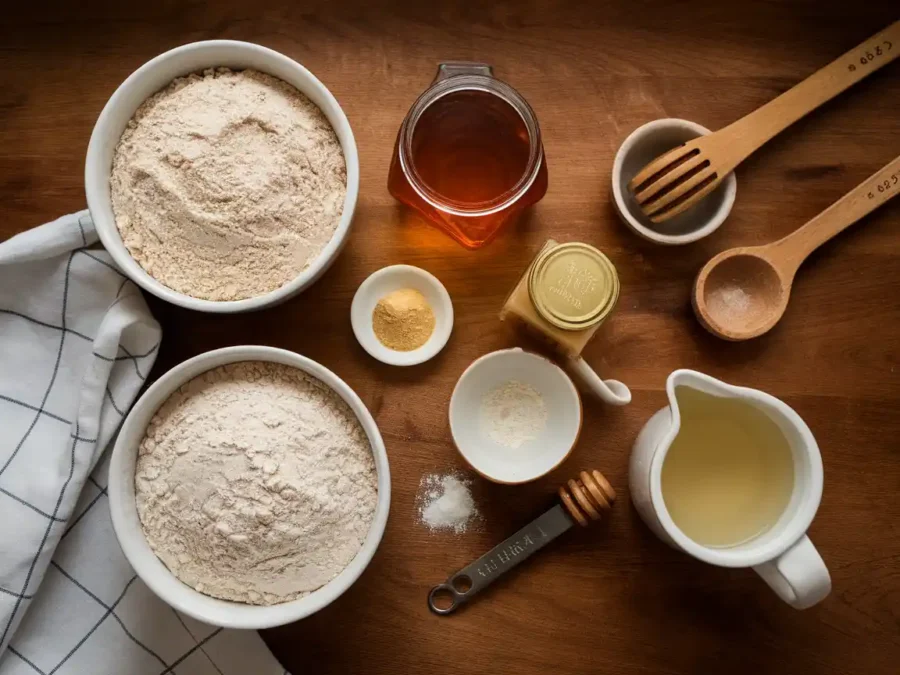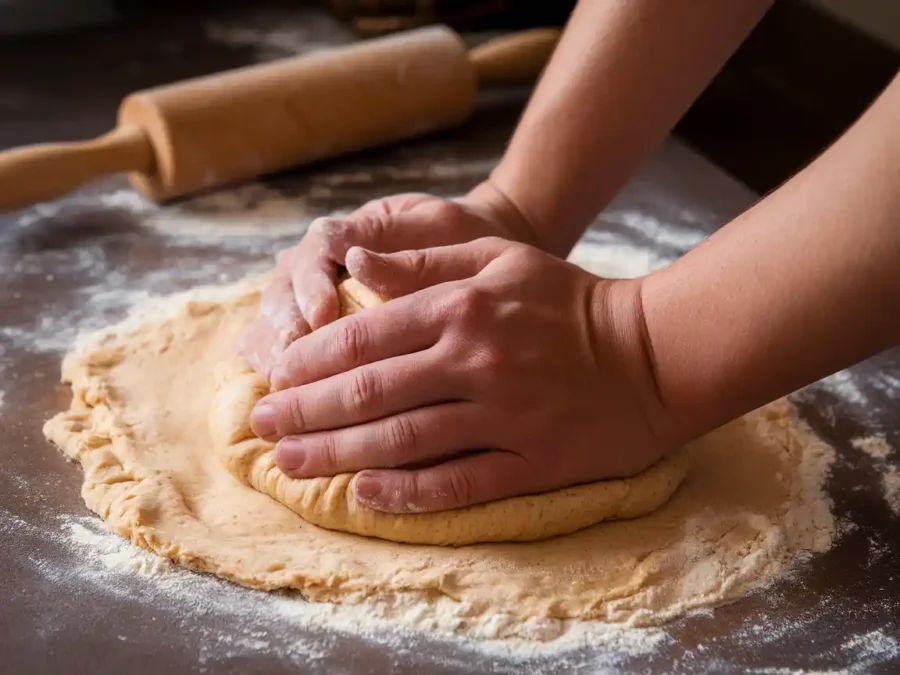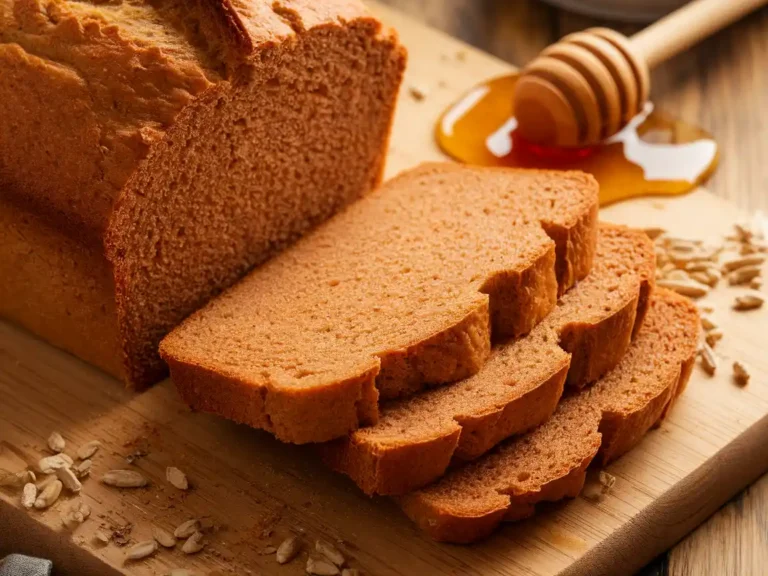The scent of freshly baked bread drifting through your kitchen is truly enchanting, and nothing captures this magic quite like a honey wheat bread recipe. This isn’t just ordinary bread it’s a comforting classic with a nutritious twist. The natural sweetness of honey pairs perfectly with the rich, nutty flavor of whole wheat, resulting in a versatile loaf suited for any occasion. Whether you’re an experienced baker or just starting out, this recipe will not only warm your home but also bring joy to your heart. Ready to get started? Let’s bake something wonderful!
Table of Contents
Why Choose a Honey Wheat Bread Recipe?
Ever wondered why honey wheat bread deserves a spot in your baking repertoire? It’s not just a loaf; it’s a lifestyle upgrade! Combining the rich nutrients of whole grains with the natural sweetness of honey, this bread delivers both flavor and health benefits.
The Nutritional Benefits of Honey Wheat Bread
Honey wheat bread offers a nutritional punch. Whole wheat flour is packed with fiber, B vitamins, and essential minerals like magnesium and zinc, which are great for digestion and overall health. Adding honey instead of sugar not only sweetens the deal but also brings antioxidants and antimicrobial properties. Isn’t it amazing how one loaf can do so much for your well-being?
“Bread is the king of the table and all else is merely the court that surrounds the king.” – Louis Bromfield
A Blend of Sweetness and Whole Grains
What makes this bread special is its balance. Unlike white bread, honey wheat bread maintains the robust texture and earthy taste of whole wheat flour but softens it with honey’s gentle sweetness. It’s the best of both worlds. Whether you’re toasting it for breakfast or pairing it with soup, honey wheat bread always shines.
Ingredients for the Best Honey Wheat Bread Recipe

Before diving into the steps, it’s important to gather your ingredients. Trust me, the better your ingredients, the better your bread.
Key Components of the Recipe
Here’s what you’ll need:
- Whole wheat flour: The heart of the recipe, providing that distinct nutty flavor.
- All-purpose flour: For a slightly lighter, fluffier loaf.
- Honey: The natural sweetener that gives this bread its signature taste.
- Yeast: The magic behind that beautiful rise.
- Salt: Because even sweet bread needs a pinch of salt to shine.
- Warm water or milk: To activate the yeast and bring the dough together.
- Butter or oil: For a soft, tender crumb.
Selecting the Best Honey for Baking
Not all honey is created equal. Opt for raw, unfiltered honey for maximum flavor and health benefits. Clover honey is a classic choice for its mild taste, but wildflower honey or even manuka honey can add unique nuances to your bread. If you want your bread to have a touch of floral sweetness, you’ll definitely want to experiment here!
Step-by-Step Guide to Making Honey Wheat Bread

Let’s roll up our sleeves this is where the magic happens. Baking honey wheat bread is an art and a science, but with these steps, you’ll feel like a pro in no time.
Preparing the Dough
Start by blooming your yeast. In a bowl, mix warm water (around 110°F) with a tablespoon of honey and your yeast. Let it sit for 5-10 minutes until it turns frothy. This step is crucial frothy yeast means happy yeast, and happy yeast means a fluffy loaf!
In a separate bowl, combine whole wheat flour, all-purpose flour, and salt. Gradually mix in the yeast mixture and the remaining honey. Add melted butter or oil to the dough, which keeps it moist and soft. Stir until the dough starts to come together, then transfer it to a floured surface.
Kneading Techniques for Perfect Bread
Kneading is where the dough’s texture transforms. Using the heel of your hand, press the dough forward, fold it back, and turn it slightly. Repeat this rhythm for about 8-10 minutes, until the dough is smooth and elastic. If it feels sticky, sprinkle on a bit more flour, but don’t overdo it you want the dough to remain soft.
“Kneading dough is like meditation for your hands it’s therapeutic and rewarding.”
Proofing: Letting the Dough Rise
Place your dough in a lightly greased bowl and cover it with a clean kitchen towel. Let it rise in a warm spot for about 1-2 hours or until it doubles in size. This is the yeast doing its job, creating air pockets that make your bread light and fluffy.
Baking the Honey Wheat Bread
Once your dough has risen, punch it down gently to release excess air. Shape it into a loaf and place it in a greased bread pan. Cover it again and let it rise for another 30-45 minutes. Meanwhile, preheat your oven to 375°F.
Bake your bread for 30-35 minutes, or until the top turns golden brown and sounds hollow when tapped. Let it cool in the pan for 10 minutes before transferring it to a wire rack. Resist the temptation to slice it right away; cooling helps the crumb set perfectly.
Common Challenges in Baking Honey Wheat Bread
Baking is as much about troubleshooting as it is about following recipes. If you’ve ever faced a loaf that’s dense, doesn’t rise, or ends up with a tough crust, don’t worry you’re not alone. Let’s tackle these common problems head-on so your honey wheat bread turns out perfect every time.
Why Does My Bread Not Rise Properly?
A loaf that doesn’t rise can be disappointing. The most common culprit? Yeast that’s past its prime or wasn’t activated correctly. Always check the expiration date on your yeast, and ensure your water temperature is just right too hot and you’ll kill the yeast; too cold and it won’t activate.
Another sneaky issue could be your proofing environment. Yeast loves warmth, so if your kitchen is chilly, try placing the dough near a slightly warm oven or wrap it in a towel to create a cozy environment.
Dealing with Overly Dense Bread
Nobody wants bread that feels like a brick. Density in honey wheat bread often comes from insufficient kneading or too much flour. Kneading develops the gluten structure, which traps air and gives the bread its fluffiness.
When adding flour during kneading, less is more. A sticky dough might be annoying, but overloading it with flour can lead to a tough texture.
Preventing a Burnt Crust While Ensuring a Cooked Interior
Ever had a loaf with a dark, tough crust and an undercooked center? The culprit here is often uneven baking. To avoid this, check your oven temperature with an oven thermometer it might be running hotter than it claims.
You can also tent your bread with aluminum foil halfway through baking to prevent over-browning while allowing the interior to cook fully.
Expert Tips for Perfect Honey Wheat Bread

When it comes to baking, the little details make a world of difference. These tips will elevate your bread from good to bakery-quality.
Achieving the Ideal Texture and Crust
For a soft, pillowy interior, avoid over-kneading once the dough is smooth and elastic. Overworking the dough can lead to a chewy, rubbery texture.
As for the crust, brushing the top with melted butter after baking keeps it tender and flavorful. If you prefer a crisp crust, leave the bread uncovered to cool it’s that simple!
Enhancing the Flavor with Additions
Want to add a personal twist to your honey wheat bread? Consider incorporating ingredients like cinnamon, raisins, or sunflower seeds. These not only boost flavor but also make the loaf uniquely yours.
You can even experiment with flavored honeys like orange blossom or lavender for a subtle flavor change. Who wouldn’t want to try bread with a hint of floral sweetness?
“Bread baking is an art that lets you be as creative as you want no loaf has to be exactly the same!”
Variations of Honey Wheat Bread to Try
One of the best things about bread is its versatility. A basic honey wheat bread recipe is like a blank canvas, ready for you to customize.
Adding Nuts and Seeds for Extra Crunch
Mix in chopped walnuts, pecans, or sunflower seeds for added texture and a nutty kick. These not only enhance the bread’s flavor but also up its nutritional value. Imagine biting into a slice and getting that satisfying crunch yum!
Sprinkling sesame or poppy seeds on top of the loaf before baking can also give it a beautiful, artisanal finish.
Vegan Honey Wheat Bread Alternatives
If you’re looking for a plant-based option, swap out the butter for coconut oil and use maple syrup instead of honey. These substitutions keep the bread moist and flavorful while catering to dietary preferences.
Vegan honey wheat bread is perfect for those who want to enjoy this classic recipe without animal-derived ingredients.
Storing and Preserving Honey Wheat Bread
You’ve baked the perfect loaf now how do you keep it fresh and delicious? Proper storage is key to enjoying your bread for days to come.
Best Practices for Keeping Bread Fresh
Honey wheat bread stays freshest when stored at room temperature in a tightly sealed container or bread bag. Avoid refrigerating bread it dries it out quickly. Instead, slice what you need and keep the rest whole to preserve its moisture.
Freezing and Reheating Tips
For longer storage, slice the bread and freeze it in a resealable bag with parchment paper between slices. This way, you can grab a slice or two as needed without thawing the entire loaf.
To reheat, pop a frozen slice in the toaster or wrap it in foil and warm it in the oven. It’ll taste just as fresh as the day you baked it.
Serving Suggestions for Honey Wheat Bread
Honey wheat bread is so versatile that it shines in both sweet and savory pairings. Let’s explore some delicious ways to enjoy it.
Pairing with Meals and Spreads
Serve your honey wheat bread with creamy butter, fruit jams, or even a drizzle of extra honey for breakfast. For lunch, it makes a killer sandwich base think turkey and cranberry, or avocado and sprouts.
For dinner, pair it with hearty soups or stews. The bread’s subtle sweetness complements savory dishes beautifully, making it a true meal enhancer.
Creative Uses for Leftover Bread
Got leftover slices? Don’t let them go to waste! Honey wheat bread makes an excellent base for French toast, croutons, or bread pudding. Cube it, toss it with olive oil and herbs, and bake for crunchy croutons that’ll elevate any salad or soup.
“Good bread is the most fundamentally satisfying of all foods.” – James Beard
Frequently Asked Questions
Baking can feel like an adventure, and questions are bound to pop up along the way. Here are some of the most common queries about honey wheat bread and their answers to ensure your baking journey is smooth and successful.
Can I Substitute Honey with Other Sweeteners?
Absolutely! While honey is the star of this recipe, you can substitute it with other natural sweeteners like maple syrup or agave nectar. Each substitution will slightly alter the flavor profile, but that’s the fun part of experimenting. If you prefer a less sweet bread, you can even try molasses for a deeper, richer flavor.
How Do I Make My Bread More Fluffy?
Fluffiness often comes down to proper kneading and proofing. Knead the dough until it’s elastic but not overly stiff. Also, allow enough time for the dough to rise it should double in size during both proofing stages. Using fresh yeast and slightly warm liquids can also help achieve a soft, airy texture.
What is the Best Flour for Honey Wheat Bread?
A mix of whole wheat flour and all-purpose flour creates the ideal balance of texture and flavor. If you want to make the bread 100% whole wheat, consider adding a tablespoon of vital wheat gluten to help the dough rise better and maintain a softer texture.
Can I Make This Bread Without a Mixer?
Yes! You don’t need fancy equipment to make honey wheat bread. Mixing by hand and kneading on a clean countertop works just as well. It might take a bit more elbow grease, but the process can be incredibly satisfying and even therapeutic.
How Can I Add More Flavor to My Bread?
Flavor enhancements are endless. Adding a teaspoon of cinnamon, orange zest, or a dash of vanilla extract to the dough can create subtle yet delightful differences. For a savory twist, try mixing in herbs like rosemary or thyme.
Is Honey Wheat Bread Gluten-Free?
Unfortunately, traditional honey wheat bread contains wheat, which is not gluten-free. However, you can explore gluten-free baking flours and recipes specifically designed for gluten-free diets. Remember, gluten-free bread often requires additional binders like xanthan gum to achieve similar texture and rise.
Conclusion: Enjoy Your Homemade Honey Wheat Bread
Congratulations! You’ve just learned everything you need to bake a stellar honey wheat bread. From the aromatic kneading process to that satisfying first bite of a warm slice fresh from the oven, the journey of making this bread is as delightful as the result.
Honey wheat bread isn’t just a recipe it’s an experience. With its perfect balance of sweetness, wholesomeness, and versatility, it’s a loaf that belongs in every kitchen. Whether you’re a novice baker or a seasoned pro, there’s always something new to explore with this recipe.
So, what are you waiting for? Gather your ingredients, preheat that oven, and let the aroma of honey wheat bread fill your home. Happy baking! 😊

